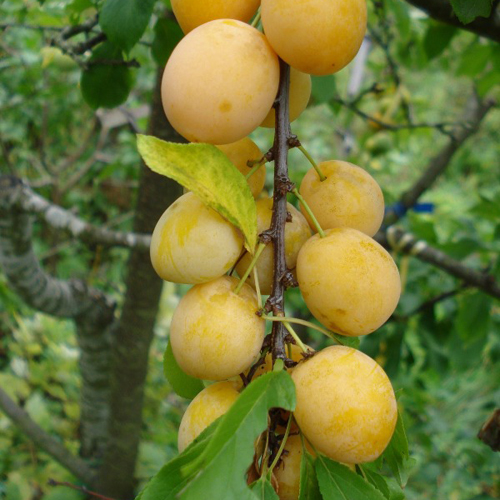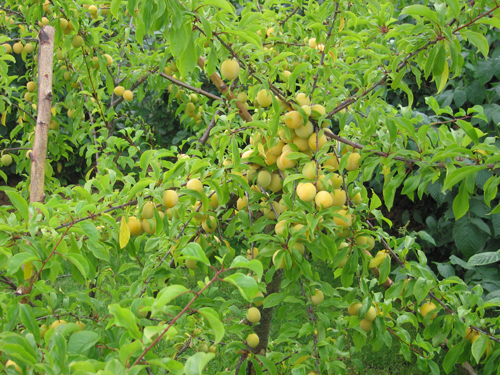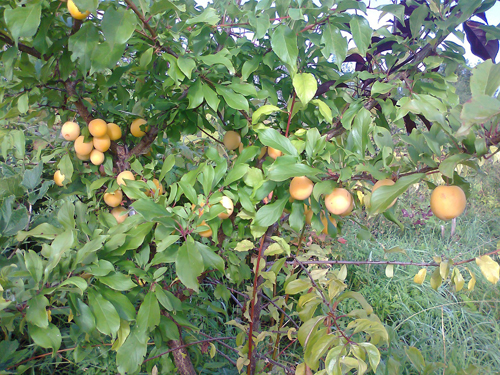Cherry plum variety Gift to St. Petersburg
Many varieties of cherry plum, which are hybrid plants, grow well in regions unfavorable for southern culture. Particularly distinguished is the variety called Gift to St. Petersburg. This is a relatively young hybrid that appeared in 1991. Many breeders had a hand in its creation. Work on pollination of cherry plum Skoroplodnaya and Pionerka began at the Crimean Experimental Breeding Station VIR, which is located in the Krasnodar Territory. The seeds obtained from the hybrids were sown, and the seedlings were isolated already in St.Petersburg at the experimental station of VNIIR im. N.I. Vavilov. Hence the name of the variety. It was entered into the State Register of Plants of the Russian Federation in 1999. Zoned in the North-West region (Vologda, Kostroma, Leningrad, Kaliningrad, Pskov, Novgorod, Tver, Yaroslavl regions). It develops well and bears fruit especially in the Kaliningrad region.

Description
The trees are mostly medium-sized (slightly over 2 meters), although the height of the tree can vary up or down. The trunk is short, the crown is wide and spreading, thick, weeping. The bark of young trees is smooth, light. Over time, it darkens and becomes slightly rough. The leaf plate is small, elongated-oval in shape with a distinctly pointed apex, the edge is finely serrated and broadly wavy. The leaf is bright light green, glabrous, with a glossy surface. At the base it is curved like a boat.
The cherry plum inflorescence consists of 2 - 4 white saucer-shaped flowers and is small in size - only 1.6 cm in diameter. Small wide-oval petals are crowned with a wavy edge. Stamens (15 in total) 7 mm high, straight. Anthers are yellow. The pistil has a slight bend. The stigma is oval, rises above the anthers. The outer part of the perianth has the shape of a glass. The sepals of the variety are oval, slightly pubescent on the inside.
The fruits of the hybrid "Gift to St. Petersburg" look very attractive outwardly. Small in size - 12 grams. The shape is elongated-ovate, with a slightly pointed tip and a small, narrow funnel. The abdominal suture is superficial, poorly expressed. The skin is of medium density, elastic, bright yellow-orange color, with a faint waxy coating. Yellow subcutaneous dots are observed on the surface. The pulp is yellow, fine-fibred, juicy, with a delicate aroma. The taste is harmonious, sweet and sour. Assessment of tasters - 4.4 points out of 5. The stone is rounded-oval, weighing 0.8 grams, which is 5.5% of the total weight of the fruit. The surface of the bone is smooth, the tip is pointed, it is difficult to separate. 100 grams of cherry plum pulp contains: dry matter - 16%, free acids - 2.9%, sugars - 8%, ascorbic acid - 12 mg, pectins - 0.76%, bioflavonoids - from 1056 mg, carotenoids - 1.7 mg.

Characteristics
- The time for fruiting crops begins in the 3rd year after planting;
- blooms early - May 6 - 21;
- A gift to St. Petersburg is famous for its stability, it brings harvests annually. The average figure from a 10-year-old tree is 27 kg, the maximum is 60 kg. The average yield from 1993 to 1999 was 97.6 c / ha;
- the harvest ripens in mid-early terms, unevenly - August 8 - 28;
- ripe cherry plum is prone to shedding, so it is not worth delaying the collection;
- the resistance of the variety to diseases and pests is not bad. In the years of mass progression of moniliosis, fruits were affected by 2 points, leaf clotteriasis - 1 point, aphids and winter moth - 1 point;
- wood and bark endure frosts at -30 ° C. But sharp fluctuations in temperature in late winter and early spring can harm flower buds. In an experiment with artificial freezing of annual shoots to -28 ° C, 55% of flower buds died in mid-February. At -35 ° C, this figure increased to 95%;
- the use of fruits is universal. In their natural form, they are healthy and delicious. Suitable for making various desserts (jelly, marmalade) and canning;
- fruits tolerate transportation and storage well.
Pollinators
Hybrid Gift to St. Petersburg refers to self-fertile, although many gardeners indicate that even without additional pollination, cherry plum sets even more than 50% of the harvest. But there is no need to experiment, for 100% certainty it is best to plant a reliable pollinator:

- Pchelnikovskaya;
- Pavlovskaya yellow;
- Pioneer.
Features of agricultural technology
The care of the variety is standard. The variety is absolutely unpretentious and undemanding to the soil, but the quality and quantity of fruits depends on the implementation of agrotechnical techniques. Pruning is mandatory, which is desirable in early spring. It will allow the crown not to grow, and to keep the rationing of fruits under control.
The advantage of the Gift to St. Petersburg is the annual stable fruiting, excellent taste and presentation of the berries. Winter hardiness for the growing region is quite sufficient. And the harvested crop can be processed into winter delicacies.
The disadvantages of cherry plum are shedding of ripe fruits, damage to flowers during temperature changes in early spring and self-fertility.








